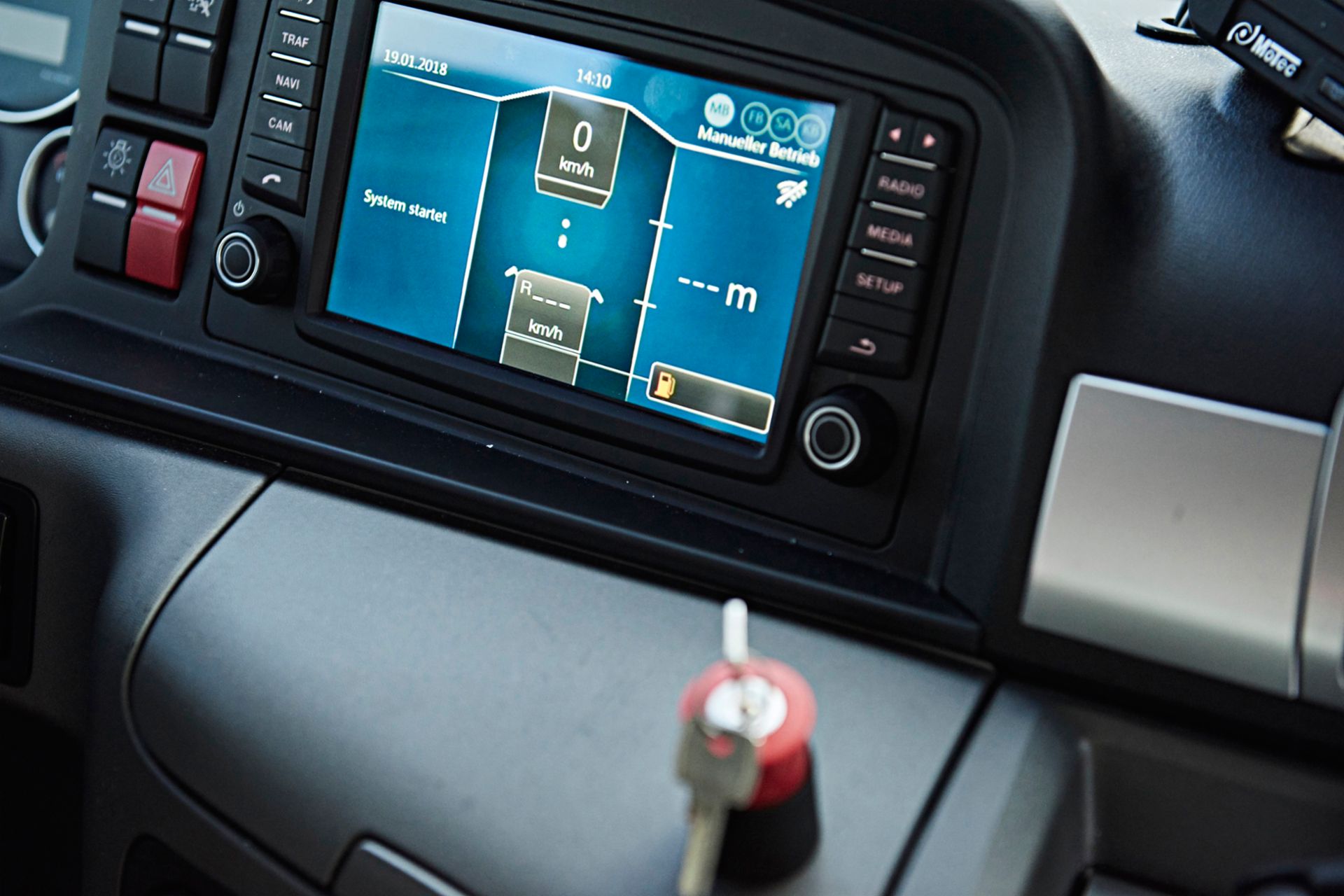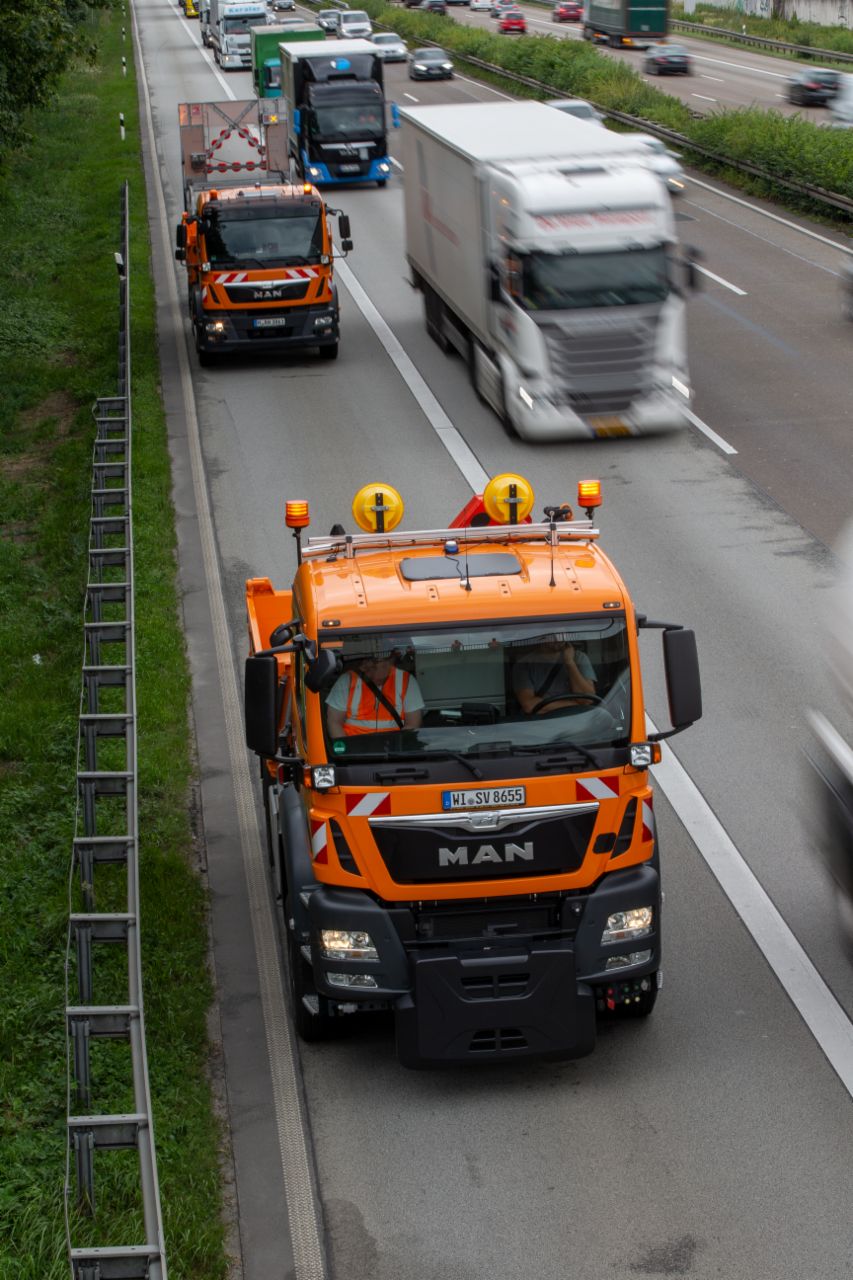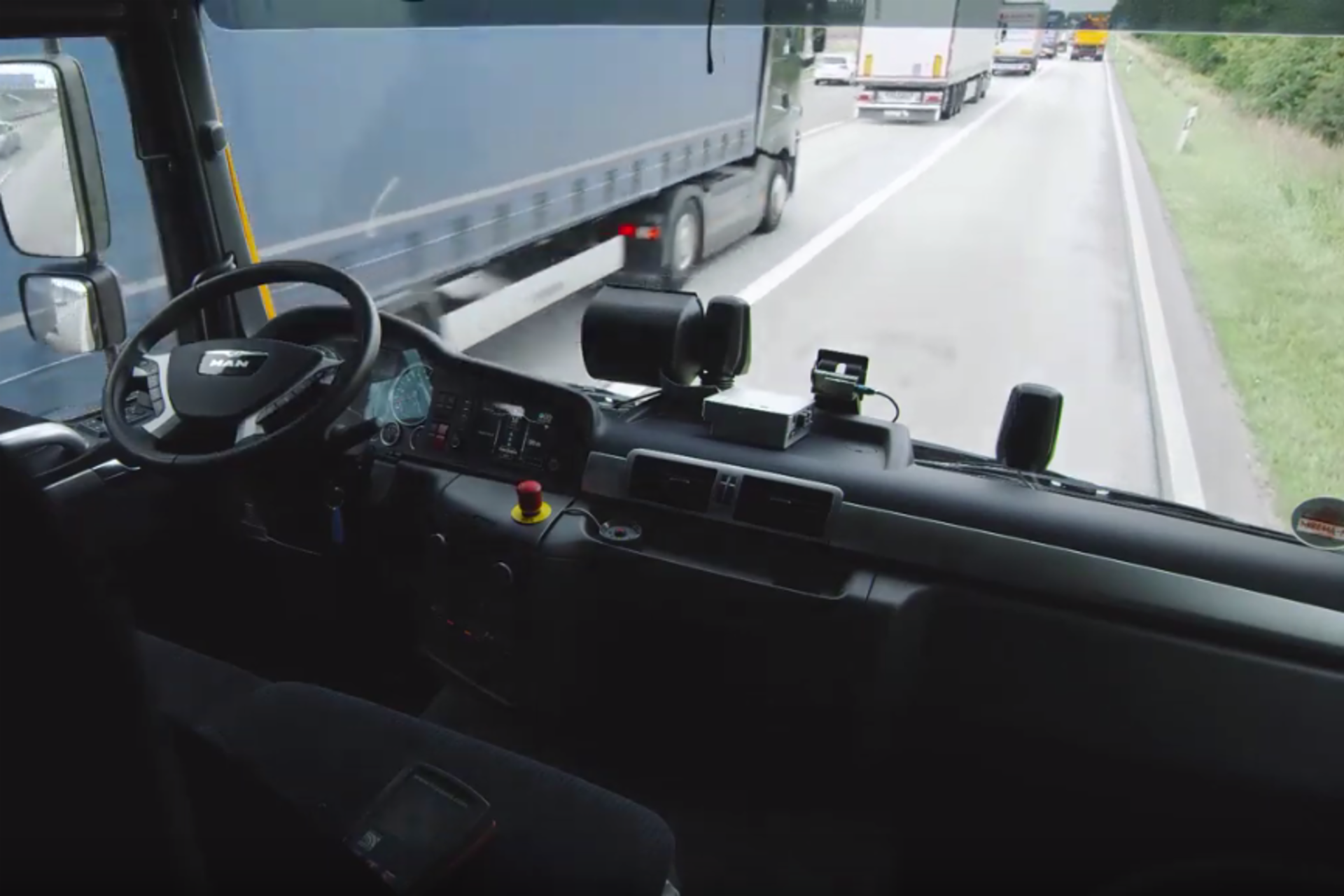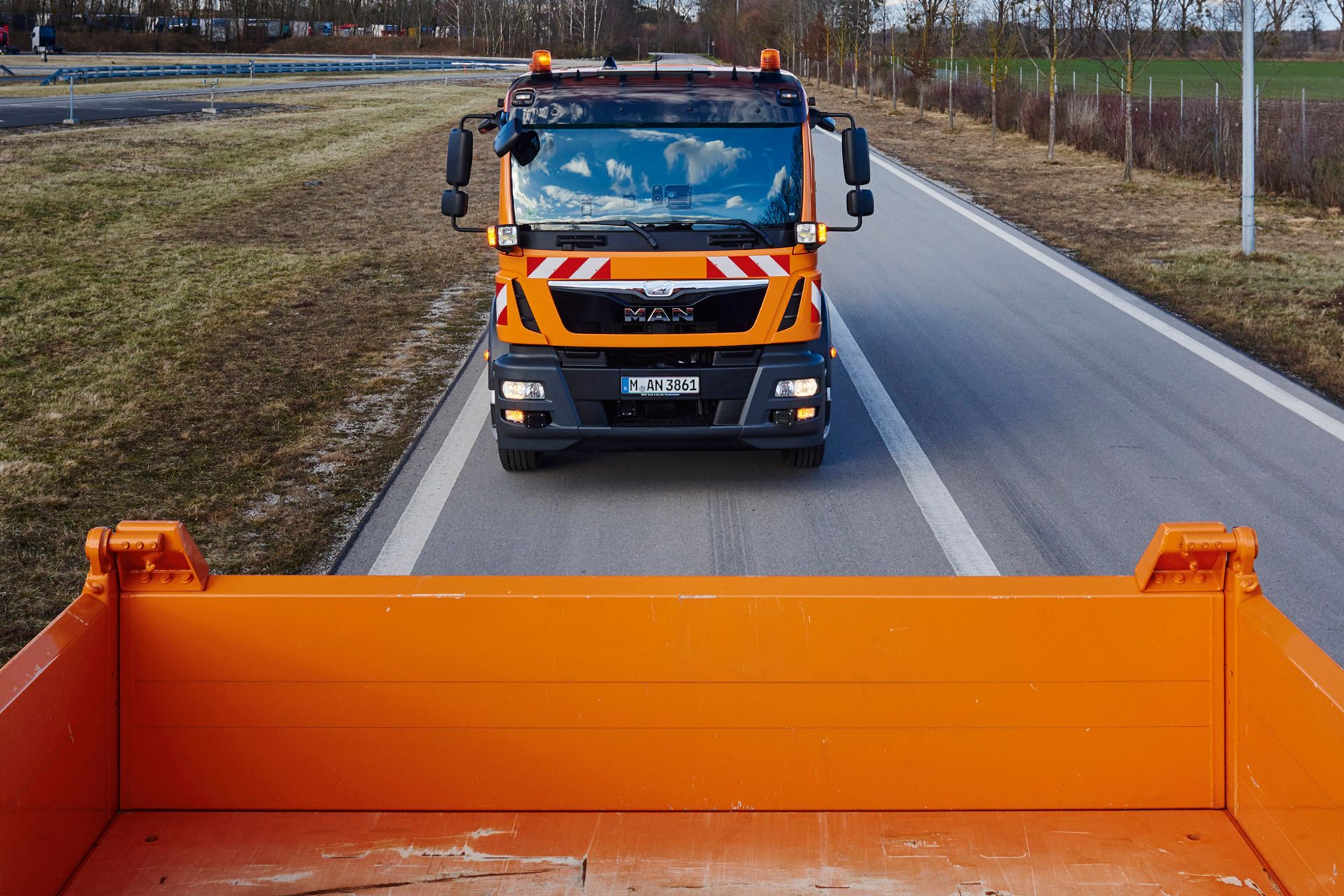
Within the fold of its “aFAS” research project, MAN is currently developing a driverless safety guard vehicle. Such technology provides higher safety levels and paves the way for the future of mobility. Traveling at a walking pace, the dumper truck moves ahead of its escort. The safeguard vehicle MAN TGM 18.340 then slowly starts up behind it. Behind the wheel is Patrick Jiskra, carefully observing every detail of what is happening, yet not needing to lift a finger. The 27-year-old functional developer works with driving assistance systems, and is currently demonstrating the future of the automotive industry, here on MAN’s test grounds in Munich: automated driverless driving. “We're now operating in coupled mode,” he explains. “That means we keep a distance of ten meters to the working vehicle in front. This allows us to easily pass entry and exit ramps on the motorway without another vehicle being able to merge in between.” And indeed, the truck manages to maintain the exact distance, even while going around bends. It remains on track, the steering wheel turning on its own, as if by magic. Once it is ready, this technology could not only assist drivers in their line of work, but also actually help to save lives.
Moving construction and maintenance sites on motorways are very dangerous for road workers: They are tasked to carry out mowing and cleaning operations, or work on guardrails in moving traffic. To ensure their safety, safeguard vehicles are deployed, which follow the working vehicle at a distance of 50 to 100 meters in order to shield them from the traffic. Yet serious rear-impact crashes often happen: In Bavaria alone, on average one vehicle collides with mobile roadworks every day—whereby it is actually the drivers of the safeguard vehicles who most often suffer heavy injuries or even fatalities. To minimize this risk, the “aFAS” (“automatic driverless safety vehicle for work sites on German highways”) project was established in August 2014. Eight partners from industry, research and government formed a cooperation to work on the development of a prototype capable of following mobile roadwork sites on the hard shoulder to protect them against traffic, and to do so in fully automated mode. Supported by the Federal Ministry of Economic Affairs, this multi-million project demands not only experience derived from road construction: The technical know-how provided by MAN and suppliers also plays a crucial role. “Our expertise is indeed based on a number of aspects,” explains Walter Schwertberger, Project Director aFAS. “And while we have the capability of establishing complete technological systems for automated driving, we are also well aware of the limits encountered by current standards for automated driving.”
“With the aFAS project, we learn how autonomous driving shall become a reality down the road.”
Walter Schwertberger, Project Director aFAS,

The aFAS project makes considerable demands on vehicle technology: Sensors, radar systems and cameras are constantly being refined to interpret rendered data even more precisely and with greater certainty—after all, the safeguard vehicle will one day drive on the motorway without a driver. “The current ISO 26262 norm demands the presence of a driver, however—and is therefore not suitable for driverless systems,” remarks Schwertberger. “While working with the aFAS project, we are learning what regulations will need to change to make autonomous driverless driving an option for the future.”
The project partners gained preliminary conclusions about technical improvements and potential changes in licensing requirements during prototype operations in the second half of 2017, as the vehicle was tested on motorway construction sites in Hesse. Equipped with state-of-the-art technology, the vehicle was deployed exclusively in closed-off sections of construction areas, so as not to endanger any drivers. Subsequently, it was returned to Munich, where the developers further optimized the technology on the basis of the experience they had gained. Since March 2018, the vehicle has once again been underway on autobahn routes in Hesse—but now in moving traffic. The project partners can therefore also observe how road users react to the autonomous driverless vehicle to see whether they recognize it as such, and if so, how this might affect their driving.
So far, legal regulations have not kept up with current technology. Gerd Riegelhuth, head of traffic and vice president of Hessen Mobil, Hesse’s public authority for road and traffic management, highlights the problem: “While the current standard actually covers autonomous driving, it does not include the steering of vehicles without a human driver. This should induce the modification of numerous laws and regulations,” says Riegelhuth. “The eighth amendment to the Road Traffic Act, however, is a step in the right direction.” One thing is certain: Autonomous driving is going to become a fact, and policy makers will have to address the reality of tomorrow’s mobility.
According to Riegelhuth, the partnership between Hessen Mobil and MAN was highly productive and also marked by a high level of trust. “It would therefore make a lot of sense to keep this issue on the agenda—and certainly with the same consortium that has already worked together so successfully on the aFAS project.”

MAN also found the experience gained from testing operations very useful. “We now know a lot more than we did three years ago,” says Jiskra. “And we’ve greatly optimized the sensors, cameras, radar and assistance systems. Nowadays, they all work much more accurately.” In the next step, a decision must be reached as to how to transfer the complex technology of autonomous driving into serial production. “By that point in time, we need to have had the discussion about how to get a serial product with more cost-effective technology solutions onto the roads. The priority right now, however, is to fine-tune the current systems.” At the moment, that would also include seeking solutions for certain challenges, such as having the commercial vehicle autonomously drive from home base to deployment location and back. “That is our next target,” foresees Jiskra. “For the time being, however, we shall continue acquiring insights from pilot operations.”
MAN’s autonomous and unmanned safety vehicle aFAS celebrated a double premiere at the IAA, where it could be seen at the TRATON stand. The vehicle was presented to the general public for the first time, and it also scooped a special award on September 19, awarded also for the first time at the IAA 2018: the “Truck Innovation Award 2019” innovation prize conferred by the International Truck of the Year (IToY) jury. Garnering a total of 93 votes, MAN’s aFAS beat the competition, comprising five other candidates, to scoop the Truck Innovation Award. One of the requirements to take part in the new Truck Innovation Award is to feature progressive, pioneering technology.
Video


